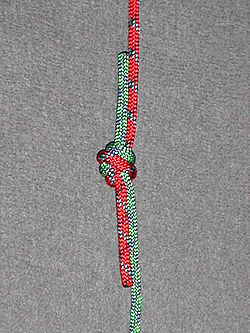Difference between revisions of "AY Honors/Knot/Ring Bend Knot/es"
From Pathfinder Wiki
< AY HonorsAY Honors/Knot/Ring Bend Knot/es
(Created page with "</noinclude>") |
(Created page with "Knot/es | name = Nudo de Agua (Nudo de Cinta) | image = Water_knot_WPK.jpg | use = El nudo de agua (o nudo de cinta) es un nudo de uso frecuente en la escalada para unir dos e...") |
||
| Line 3: | Line 3: | ||
{{ | {{ | ||
| − | Knot | + | Knot/es |
| − | | name = | + | | name = Nudo de Agua (Nudo de Cinta) |
| image = Water_knot_WPK.jpg | | image = Water_knot_WPK.jpg | ||
| − | | use = | + | | use = El nudo de agua (o nudo de cinta) es un nudo de uso frecuente en la escalada para unir dos extremos de correas juntas, por ejemplo, al hacer un cabestrillo. |
The ends should be left at least three inches long and the knot should be "set" by tightening it with full body weight. The ends can be taped or lightly sewn to the standing parts to help prevent them from creeping back into the knot. Inspect the knot before each use. | The ends should be left at least three inches long and the knot should be "set" by tightening it with full body weight. The ends can be taped or lightly sewn to the standing parts to help prevent them from creeping back into the knot. Inspect the knot before each use. | ||
Revision as of 18:36, 26 June 2016
| Nudo de Agua (Nudo de Cinta) |
|---|
|
Uso: El nudo de agua (o nudo de cinta) es un nudo de uso frecuente en la escalada para unir dos extremos de correas juntas, por ejemplo, al hacer un cabestrillo.
The ends should be left at least three inches long and the knot should be "set" by tightening it with full body weight. The ends can be taped or lightly sewn to the standing parts to help prevent them from creeping back into the knot. Inspect the knot before each use.
Cómo amarrar:
|

